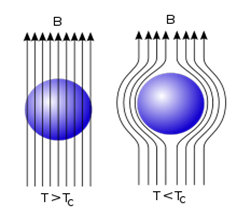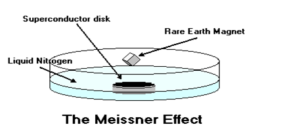Meissner Effect Experiment | Meissner Effect Explanation:
When superconducting materials reach their critical temperature two exciting properties appear. Firstly, the electrical resistance of the material drops rapidly to zero and secondly, they become perfect diamagnets by excluding all magnetic flux from the superconductor known as Meissner effect. A superconductor is therefore a perfect diamagnet in meissner state.this all happens because of the generation of super currents caused by the flow of bounded pair of electrons (cooper pair) inside the superconducting sample cooled below its critical temperature in presence of an external magnetic field greater than its critical field.

This superconductivity occurs at very low temperatures. The early superconductors reached critical temperature at the temperature of liquid helium (4K). This made them expensive and difficult to use. Further research discovered mixed oxide compounds that reached critical temperature at the temperature of liquid nitrogen. This made the use of superconductors more practical. The hope of future research is to find a superconductor that will operate at room temperature.
The following diagram explains the Meissner effect.

The exclusion of the magnetic field from the superconductor takes place regardless of whether the sample becomes superconducting before or after the external magnetic field is applied. In the steady state, the external magnetic field is cancelled in the interior of the superconductor by opposing magnetic fields produced by a steady screening current that flows on the surface of the superconductor.
It is important to recognise that the exclusion of the magnetic field from inside a superconductor cannot be predicted by applying Maxwell’s equations to a material that has zero electrical resistance. We shall refer to a material that has zero resistance but does not exhibit the Meissner effect as a perfect conductor, and we shall show that a superconductor has additional properties besides those that can be predicted from its zero resistance.
Meissner Effect Demonstration:
The procedure below, will guide the experimenter through a demonstration of the Meissner Effect in a cookbook fashion, step by step.
The shallow dish-like depression in the styrofoam container for the kit, or a third of an inch high portion of the bottom of a styrofoam coffee cup, can be used for holding liquid nitrogen for the experiment. To project a sharp image of the Meissner Effect with an overhead projector, use a very small dish so that the levitated magnet is less than an inch from its glass plate.
Procedure:

- ACTION
Carefully pour a small amount of liquid nitrogen into the dish or styrofoam cup until the liquid is about a quarter of an inch deep.RESULT: The liquid boils furiously for a short while. Wait until it stops boiling.
- ACTION
Using the provided tweezers, carefully place the black superconductor disk flat in the liquid until its top is just flush with the surface of the liquid nitrogen.RESULT: Again, the nitrogen boils around the disk. Wait until this boiling stops too.
- ACTION
Again using the tweezers, pick up the provided magnet, and attempt to balance it on top of the superconductor disk.RESULT: Instead of settling down onto the surface of the superconductor, the magnet will simply `float’ a few millimeters above the superconductor
This is a demonstration of the Meissner Effect.
Be Careful:
the Meissner effect is different from induction! Indeed, the classic laws of electromagnetism enable a magnetic field that is not equal to zero to go through a perfect metal (R = 0). In such a case, the variation of the magnetic field is not permitted (dB/dt = 0). However, in the Meissner effect, the magnetic field does not change in time; the magnet remains the same, and yet it starts to levitate.
